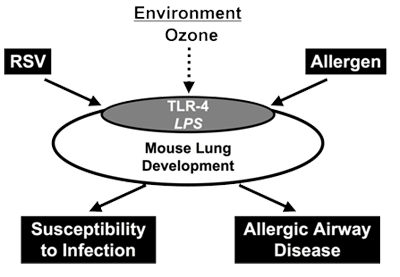Project Leaders: Azzeddine Dakhama, PhD and Carl White, MD
Project Personnel: Kelsa Gabehart, PhD, Kelly Correll
Background
Inhaled air pollutants such as ozone are known to exacerbate asthma and may play a potential role in the inception of reactive airway disease in early life. While ozone can cause significant respiratory health problems in the majority of exposed individuals, young children are particularly at greater risk for developing serious adverse health effects from ozone exposure. This is because their lungs are still developing rapidly, and exposures during this critical window of susceptibility may alter lung development, resulting in permanent respiratory health problems. Air pollutants may also influence the developing immune system in young children, increasing susceptibility to infection and promoting airway sensitization to common aeroallergens.
Hypothesis
The overall objective of this project is to define how ozone influences lung development and host immune response in early postnatal life. Our general hypothesis is that ozone exposure in the early postnatal phase alters lung development and modifies the host immune response to early life viral infection and allergen exposure, thereby contributing to the development of reactive airway disease.
Specific Aims
To define the influence of ozone on innate immune response, airway structure and function. Studies are designed to identify which toll-like receptors (TLRs) are modified following postnatal ozone exposure, to define the changes in airway structure and function, and to determine the role of TLR-4 in these responses.
To define the influence of ozone on the early host response to respiratory syncytial virus (RSV) infection and house dust mite (HDM) allergen exposure. The proposed studies will determine how ozone modifies the host response to RSV and HDM during the postnatal phase and will define the associated changes in airway structure and function and the role of TLR-4 in these responses.
To determine how lipopolysaccharide (LPS), an air contaminant that interacts with TLR-4, modifies the host response to RSV and HDM following postnatal ozone exposure. We will determine how LPS modifies the early host response to RSV and HDM, and associated changes in airway structure and function, following postnatal ozone exposure.
